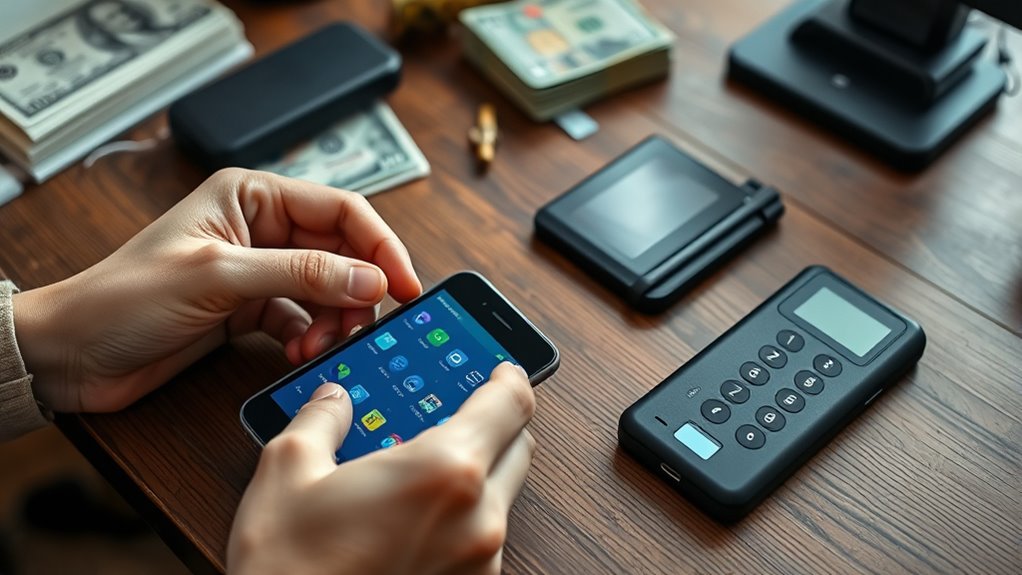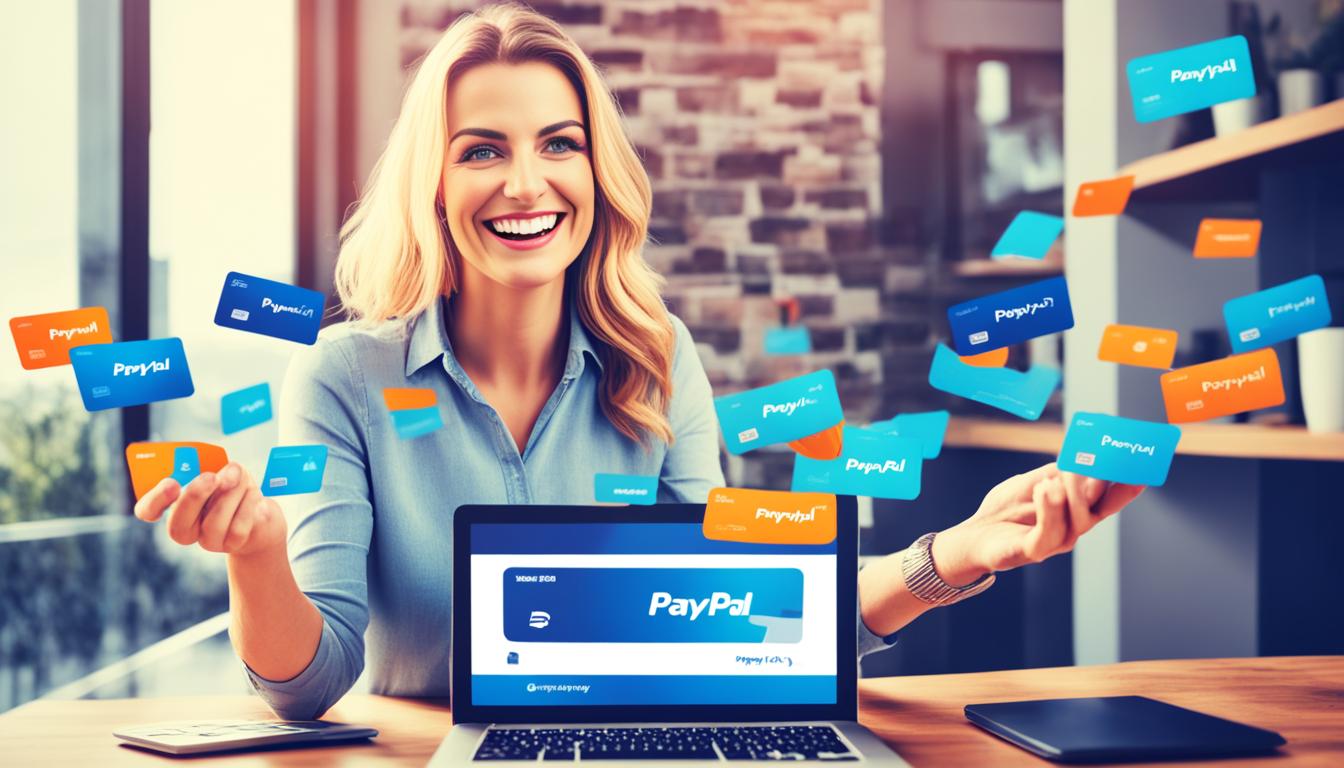To establish backup payment options quickly, add prepaid cards and digital wallets like Apple Pay or Google Pay to your devices. Keep physical cash in a secure location and make sure your credit cards are active and updated, with fraud protections in place. Inform your card providers about your backup plans to avoid blocks. Having these options ready ensures you’re prepared for any emergency—stay tuned to learn even more ways to become financially resilient.
Key Takeaways
- Link multiple bank accounts and digital wallets to ensure seamless access during emergencies.
- Keep physical prepaid cards and cash reserves in accessible, secure locations for quick use.
- Update and secure mobile payment apps with PINs, biometrics, and emergency contact info.
- Notify your card issuers about backup plans to prevent transaction blocks or fraud alerts.
- Regularly review and rotate cash and digital assets to maintain readiness for urgent situations.

Emergencies can strike unexpectedly, making reliable payment methods vital. When urgent situations arise—whether it’s a sudden medical expense, a last-minute trip, or an unexpected outage—you need to guarantee your money is accessible without hassle. Relying solely on one payment method leaves you vulnerable to delays and inconveniences. To stay prepared, it’s wise to set up multiple backup payment options that can be used seamlessly when your primary method fails.
Emergencies happen unexpectedly; having multiple backup payment options ensures quick, hassle-free access to your funds when it matters most.
Diversifying your payment methods reduces the risk of transaction failures during emergencies. Common backups include credit cards, prepaid cards, digital wallets, cash reserves, and mobile payment apps. Having a credit card as a backup provides extra security and acceptance, especially in situations requiring official verification. Prepaid cards are a practical choice because you can load them in advance, avoiding credit risk and controlling spending. These cards are widely accepted at most merchants that accept standard credit or debit cards and can be purchased anonymously or for family members needing emergency funds. Research shows that consumers who diversify their payment options are less likely to face disruptions during urgent needs.
Digital wallets like Apple Pay or Google Pay offer quick, contactless access to funds if physical cards are lost or damaged. Linking multiple cards and bank accounts to your digital wallets allows you to swap payment sources effortlessly during urgent moments. Just make sure your mobile payment apps are updated, and your smartphone’s security features (PINs or biometrics) are enabled to protect your digital assets. Keep your phone charged with portable chargers or power banks, as dependence on smartphone batteries is a key consideration.
Carrying a small amount of cash remains vital despite the rise of digital payments. Cash is often the only reliable method during power outages, network failures, or outages affecting electronic payments. Store your cash securely at home or in a safe deposit box, and rotate it periodically to maintain its freshness and availability. Cash provides immediate access to essentials like food, transportation, or medical supplies without relying on technological infrastructure.
Setting up backup payment options isn’t just about convenience; it’s about avoiding transaction delays that could cause severe inconvenience or penalties. Choose credit cards with no annual fees and strong fraud protection, and inform your card issuers about your backup plans to prevent fraud alerts from blocking emergency transactions. Keep your physical cards updated in online accounts and wallets to guarantee quick access when needed. Consider cards with emergency replacement services so you can recover quickly if your card is lost or stolen.
Frequently Asked Questions
How Do I Choose the Best Backup Payment Method for My Needs?
When choosing the best backup payment method, you should consider what devices your customers use most and prioritize options like digital wallets or credit cards compatible with those devices. Look for secure solutions with encryption, low or no fees, and easy setup. Make sure it integrates smoothly with your existing systems and is widely accepted. This way, you guarantee quick, safe transactions during emergencies without disrupting your business flow.
Are There Any Fees Associated With Setting up Backup Payment Options?
You might wonder if setting up backup payment options costs anything. Usually, there are no setup fees involved, and most platforms don’t charge for adding or maintaining backup methods. The charges only happen if the backup payment is used, such as when your primary card fails. Keep in mind that transaction fees from your bank or card issuer might apply, but the process of setting up backup options itself is typically free.
Can I Use Digital Wallets as Backup Payment Methods?
Think of digital wallets as your financial safety net, ready to catch you when your primary payment methods fail. You can definitely use digital wallets as backup payment options, thanks to their widespread acceptance, robust security, and flexibility. They maintain functionality even if your card expires, and advanced authentication ensures smooth transactions. With growing popularity worldwide, digital wallets are an increasingly dependable choice for emergency backup payments.
How Secure Are Backup Payment Options During Emergencies?
You might wonder how secure backup payment options are during emergencies. They’re generally safer than cash or offline cards because transactions are traceable and monitored. However, they face risks like malware, phishing, and hacking of payment terminals or wireless signals. To protect yourself, use biometric authentication, keep your software updated, and choose trusted, encrypted platforms. Staying vigilant guarantees your backup payments remain as protected as possible during urgent situations.
What Should I Do if My Backup Payment Fails Unexpectedly?
If your backup payment fails unexpectedly, first verify that your alternative payment methods are active and correctly entered. Retry the transaction after resolving any identified issues, and notify your customers or stakeholders about the problem and next steps. If the failure persists, escalate the issue to support teams or banks. Always have contingency plans in place, like emergency payment systems, to minimize disruptions and maintain trust.
Conclusion
So, next time you’re caught off guard, remember that having backup payment options isn’t just smart—it’s a lifesaver. You might find yourself in a situation where your main card is declined, only to realize you set up that extra account months ago. It’s funny how those small precautions can save the day when you least expect it. Stay prepared, and you’ll always have a safety net, no matter what surprises come your way.









